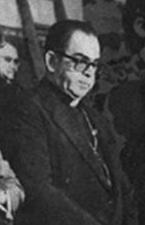Arturo Rivera y Damas facts for kids
Quick facts for kids The Most Reverend Arturo Rivera y Damas S.D.B. |
|
|---|---|
| Archbishop of San Salvador | |
 |
|
| See | San Salvador |
| Enthroned | 28 February 1983 |
| Reign ended | 26 November 1994 |
| Predecessor | Óscar Romero |
| Successor | Fernando Sáenz Lacalle |
| Other posts | Bishop of Santiago de María (1977–1983) Auxiliary Bishop of San Salvador (1960–1977) |
| Orders | |
| Ordination | 19 September 1953 |
| Consecration | 23 October 1960 by Luis Chávez y González |
| Personal details | |
| Born | 30 September 1923 San Esteban Catarina, El Salvador |
| Died | 26 November 1994 (aged 71) San Salvador, El Salvador |
| Denomination | Roman Catholic Church |
| Residence | San Salvador |
| Styles of Arturo Rivera y Damas |
|
|---|---|
 |
|
| Reference style | The Most Reverend |
| Spoken style | Your Excellency |
| Religious style | Monsignor |
Arturo Rivera y Damas (born September 30, 1923 – died November 26, 1994) was an important religious leader in El Salvador. He was the ninth Bishop and fifth Archbishop of San Salvador. His time as archbishop, from 1983 to 1994, happened during the Salvadoran Civil War.
Archbishop Rivera y Damas was the person who took over after Archbishop Óscar Romero. During Romero's time as archbishop (1977–1980), Rivera y Damas was a key supporter. He had also been an assistant to the long-serving Archbishop Luis Chávez y González (1938–1977). He was also a friend of Mother Teresa, who stayed at his family home when she visited El Salvador.
Contents
About Arturo Rivera y Damas
Early Life and Priesthood
Arturo Rivera y Damas was born in San Esteban Catarina, El Salvador, on September 30, 1923. He became a priest on September 19, 1953. He joined the order of the Salesians of Don Bosco. Rivera y Damas once said he joined the Salesians because he wanted to help poor people. He felt they were the ones doing that important work.
Becoming a Bishop
On July 30, 1960, he was made an Auxiliary Bishop of San Salvador. This meant he was an assistant bishop. He also supported the work of Father Rutilio Grande. Father Grande was doing new and sometimes controversial work with people in the countryside around San Salvador.
Some people in the Church leadership did not approve of Rivera y Damas's ideas. They thought he was too progressive. Because of his work, some even called him a "red bishop." This meant they saw him as too radical or too close to political movements.
Bishop of Santiago de María
In September 1977, Rivera y Damas became the Bishop of Santiago de María. This was the same position Óscar Romero had held before becoming archbishop.
During Archbishop Romero's time, Rivera y Damas was often his only ally among the bishops in El Salvador. The bishops were divided. Some were more traditional, while others were influenced by new ideas from the Second Vatican Council. This council was a big meeting of Catholic leaders that brought many changes to the Church. Rivera y Damas attended these important meetings.
Archbishop During the Civil War
After Archbishop Romero was killed on March 24, 1980, Rivera y Damas was put in charge of the archdiocese. However, he was not made archbishop right away. He finally became archbishop in February 1983.
His time as archbishop was very difficult. He had to speak out against unfairness and war crimes, but he also had to be careful to avoid the same fate as Romero. The Church, led by Rivera y Damas, helped to watch over the peace process. This was done alongside the United Nations.
In 1989, a very sad event happened during the Civil War. Several Jesuit priests and their staff at the Central American University of San Salvador were killed. This event reminded many people of Romero's death. Archbishop Rivera y Damas reportedly told the President of El Salvador, Alfredo Cristiani, to put soldiers outside his office. He said, "If I'm killed, I want it clear who did it." This showed his bravery.
Working for Peace
The killings at the university put more pressure on the government to end the war. Archbishop Rivera y Damas helped with the talks that led to the final Peace Accords. These agreements were signed in 1992 between the Farabundo Martí National Liberation Front (FMLN) and the Salvadoran government.
In his last years, Rivera y Damas worked to start the process of making his friend, Óscar Romero, a saint.
Death and Legacy
Arturo Rivera y Damas passed away on November 26, 1994. Later, in 1996, Pope John Paul II visited the Metropolitan Cathedral of San Salvador. This is where Rivera y Damas and other archbishops are buried. The Pope said that Rivera y Damas "entered into eternity after having seen the peace, for which he and the other bishops of El Salvador had worked tirelessly, burst over the horizon." This means Rivera y Damas saw peace come to his country before he died.

See also
 In Spanish: Arturo Rivera y Damas para niños
In Spanish: Arturo Rivera y Damas para niños

